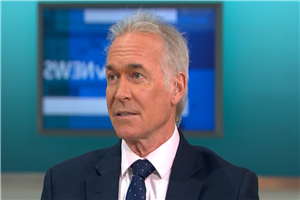GOOD Morning Britain's Dr Hilary Jones has warned of the hidden threat of breast cancer in the wake of Sarah Harding's death.
The Girls Aloud star was diagnosed with advanced breast cancer last August and underwent a mastectomy and chemotherapy in a bid to prolong her life.
Her heartbroken mum Marie yesterday confirmed her death after she fought the disease for 12 months.
Speaking on Good Morning Britain (GMB) today, Dr Hilary revealed the early warning signs that everyone should be looking out for.
While most people look out for a lump or bump on their breast, Dr Hilary said one of Sarah's symptoms had been a lump under the armpit.
GMB host Susanna Reid added that it was "far to young" for Sarah to have died at the age of 39 and questioned how unusual this had been.
Dr Hilary said: "It's rare, we hear a lot about breast cancer in younger women because it's so shocking when it happens.
"About five per cent of cases occur in women under 40, so being aware of the early signs and symptoms is still really important.
"If people are worried that there has been a change in the size and shape, the texture of the breast, if there is any puckering of the skin, any in-pulling of the nipple, any discharge – anything like that."
He then highlighted a graphic of the different breast cancer symptoms and said that 'hopefully' people are becoming more aware of these.
Susanna then highlighted that for Sarah, it had been a lump under her armpit that had been concerning.
Dr Hilary added: "The lymph glands were the first sign for her and if in doubt just go and get it checked out.
"I know people are finding it difficult to get appointments with their GP face-to-face at the moment.
"Cancer cases are prioritised, if you think you have anything suspicious like that then even if it's triage first or an online consultation, you will be seen face-to-face by the doctor and referred urgently for investigation and treatment."
DIAGNOSIS
Sarah first discovered a cyst during the pandemic and didn't go to the hospital straight away as she was concerned about overrun hospitals.
She announced her diagnosis in August last year.
She posted a photo of herself from her hospital bed and said she was "fighting as hard as I possibly can".
How to check for breast cancer?
There is a five-step self exam you can do at home to check for any changes.
- Step one: Begin by looking in a mirror, facing it with your arms on your hips and your shoulders straight. You should be looking for any dimpling, puckering, bulging skin, redness, soreness, a rash or changes in the nipple.
- Step two: Still looking in the mirror, raise both arms above your head and check for the same changes.
- Step three: With your arms still above your head, check for any fluid coming from the nipples. This can include milky, yellow or watery fluid, or blood.
- Step four: While lying down use your opposite hand to check each breast. Using a few fingers, keeping them flat and together, go in a small circular motion around your breasts. Make sure you feel the entire breast by going top to bottom in these small circles. It helps to develop a system or pattern to make sure every inch is covered. Use light pressure for the skin and tissue just beneath, medium pressure for the tissue in the middle of your breasts, and firm pressure to feel the tissue at the back, feeling down to your ribcage.
- Step five: Feel your breasts while either standing or sitting, using the same small circular motions.
KNOW THE SIGNS
Around one in eight women are diagnosed with breast cancer, although recovery chances are high if detected early.
Breast cancer often causes changes in the breast, including an alteration in the shape or size in both or one of your breasts.
Sometimes there may be a lump which feels thicker or harder than the rest of the tissue.
The skin on your breast may change, causing puckering or dimpling, that can resemble orange peel.
A rash may appear or your skin may seem redder, especially around the nipple.
Your nipple may also change shape, and appear stretched, and liquid may leak from the nipples, even without being squeezed.
The nipples may also become sunken or inverted. You may experience pain in your breast – or armpit – and there may be a swelling around your collarbone or armpit.
Some changes that occur may not be a sign of cancer but normal changes or a benign lump.
If you are concerned about any changes in your breasts then you should see a GP.
Charity Breast Cancer Now and CoppaFeel! have more information and support for people who have been diagnosed, are living with or in remission from breast cancer. The NHS website also has a page dedicated to breast cancer.
We pay for your stories!
Do you have a story for The Sun news desk?
Email us at [email protected] or call 02077824104. You can WhatsApp us on 07423 720 250. We pay for videos too. Click here to upload yours
Click here to get The Sun newspaper delivered for FREE for the next six weeks.
Source: Read Full Article



